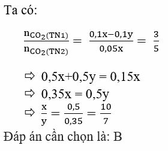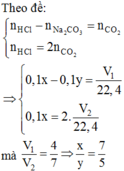rộn V1 ml dung dịch axit clohiđric có nồng độ 0,5M với V2 ml dung dịch axit clohiđric cÓ nồng độ 3M ta thu được 100 ml dung dịch axit clohiđric có nồng độ 2,5M tính V1 và V2
Hãy nhập câu hỏi của bạn vào đây, nếu là tài khoản VIP, bạn sẽ được ưu tiên trả lời.


PTHH: \(Ba\left(OH\right)_2+2HCl\rightarrow BaCl_2+2H_2O\)
Ta có: \(\left\{{}\begin{matrix}n_{Ba\left(OH\right)_2}=0,05\cdot0,5=0,025\left(mol\right)\\n_{HCl}=0,15\cdot0,1=0,015\left(mol\right)\end{matrix}\right.\)
Xét tỉ lệ: \(\dfrac{0,025}{1}>\dfrac{0,015}{2}\) \(\Rightarrow\) Ba(OH)2 còn dư, dd sau p/ứ có tính kiềm
\(\Rightarrow\left\{{}\begin{matrix}n_{BaCl_2}=0,0075\left(mol\right)\\n_{Ba\left(OH\right)_2\left(dư\right)}=0,0175\left(mol\right)\end{matrix}\right.\) \(\Rightarrow\left\{{}\begin{matrix}C_{M_{BaCl_2}}=\dfrac{0,0075}{0,05+0,15}=0,0375\left(M\right)\\C_{M_{Ba\left(OH\right)_2}}=\dfrac{0,0175}{0,2}=0,0875\left(M\right)\end{matrix}\right.\)

\(n_{Fe}=\dfrac{36,4}{56}=0,65\left(mol\right)\)
PTHH: Fe + 2HCl ---> FeCl2 + H2
0,65->1,3----->0,65--->0,65
=> \(\left\{{}\begin{matrix}a,V_{ddHCl}=\dfrac{1,3}{0,5}=2,6\left(l\right)\\b,V_{H_2}=0,65.22,4=14,56\left(l\right)\end{matrix}\right.\)
c, \(C_{M\left(FeCl_2\right)}=\dfrac{0,65}{2,6}=0,25M\)

\(a,n_{Mg}=\dfrac{7,2}{24}=0,3\left(mol\right)\)
PTHH: \(Mg+2HCl\rightarrow MgCl_2+H_2\)
0,3--->0,6------------------->0,3
\(b,C_{M\left(HCl\right)}=\dfrac{0,6}{0,5}=1,2M\\ c,n_{CuO}=\dfrac{16}{80}=0,2\left(mol\right)\)
PTHH: \(CuO+H_2\xrightarrow[]{t^o}Cu+H_2O\)
LTL: 0,2 < 0,3 ---> H2 đủ
\(n_{Mg}=\dfrac{7,2}{24}=0,3\left(mol\right)\\ pthh:Mg+2HCl\rightarrow MgCl_2+H_2\uparrow\)
0,3 0,6 0,3
\(C_{M\left(HCl\right)}=\dfrac{0,6}{0,5}=1,2M\\ n_{CuO}=\dfrac{16}{80}=0,2\left(mol\right)\\ pthh:CuO+H_2\underrightarrow{t^o}Cu+H_2O\\ LTL:\dfrac{0,2}{1}< \dfrac{0,3}{1}\)
=> H2 có khử hết

\(\begin{array} {l} a)\\ Mg+2HCl\to MgCl_2+H_2\\ b)\\ n_{Mg}=\dfrac{7,2}{24}=0,3(mol)\\ \text{Theo PT: }n_{HCl}=2n_{Mg}=0,6(mol)\\ 500ml=0,5l\\ \to C_{M\,HCl}=\dfrac{0,6}{0,5}=1,2M\\ c)\\ n_{CuO}=\dfrac{16}{80}=0,2(mol)\\ \text{Theo PT: }n_{H_2}=n_{Mg}=0,3(mol)\\ CuO+H_2\xrightarrow{t^o}Cu+H_2O\\ \text{Vì }n_{CuO}<n_{H_2}\to H_2\text{ dư}\\ \text{Vậy lượng hiđro đủ để khử hết }16g\,CuO\end{array}\)



Ta có: nHCl(trong V1) = 0,5V1 (mol)
nHCl(trong V2 ) = 3V2 (mol)
nHCl(sau khi trộn) = 0,1 x 2,5 = 0,25 (mol)
=> 0,5V1 + 3V2 = 0,25 (1)
Lại có: Thể tích dung dịch thu được là 100(ml) = 0,1 (lít)
=> V1 + V2 = 0,1 (2)
Từ (1), (2), ta có hệ phương trình:
\(\left\{\begin{matrix}0,5V_1+3V_2=0,25\\V_1+V_2=0,1\end{matrix}\right.\)
\(\Rightarrow\left\{\begin{matrix}V_1=0,02\left(l\right)=20\left(ml\right)\\V_2=0,08\left(l\right)=80\left(ml\right)\end{matrix}\right.\)